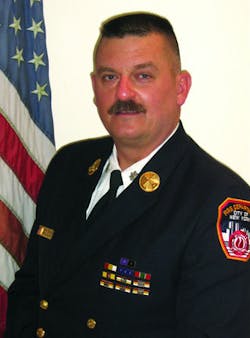I have always been a big believer in every firefighter carrying a tool. I am also sometimes amazed when watching a news report of a fire or, even more commonly, an auto accident, and I see many firefighters moving around a scene without a tool anywhere in sight. Now before anyone gets confused, I need to be clear that I am talking about hand tools—axes, Halligans, hooks, thermal imaging cameras, K tools, etc. I am also going to talk a little about radios and flashlights. So let’s look at who is carrying the tools.
Common scenario
Now I know that every fire department does not have the same staffing and the number of firefighters who respond on any particular apparatus varies greatly. For this reason, I am going to use a scenario involving basic operations and the first few companies that might arrive on scene. I should mention that firefighters pulling a hoseline don’t have to carry a hand tool unless there are no other firefighters on scene.
Engine 1 pulls up to a reported smoke condition in a private dwelling. There is a tiny bit of smoke coming out the front door, which has been chocked open by the occupant.
The engine officer gets off the rig and, if they are equipped with a TIC, they should be carrying it. Do they need to carry anything else? Of course! If the staffing is very light, like one other firefighter, the officer needs to carry either a Halligan or even a set of irons (axe and Halligan).
If there is another firefighter on the rig in addition to the driver, that firefighter will almost certainly be pulling the hoseline if needed. Is one set of tools and a hoseline enough for this operation? Yes!
But what if there are two or three working firefighters on the rig? If there is a truck or other second-arriving company responding, the remaining members can all be used to stretch and operate the hoseline. One of them can even carry those tools rather than the officer.
Now a ladder company arrives as the engine crew is starting to stretch their hoseline into the house. Their officer gets off the rig and they too are carrying a TIC and a hand tool. If there is a team of two firefighters on board, one should carry a set of irons (yes, both tools), and the other should carry a 6-foot hook (it’s not a pike pole, but we will talk about that some other time).
With those three tools, this team of firefighters can perform many vital tasks. They can force just about any door, they can pull trim from windows and walls, they can cut a floor, they can pull a ceiling, they pry and pull and separate just about anything in a house. If there are more firefighters or even later-arriving companies, they too should be carrying a variety of hand tools. Sometimes a metal Halligan hook might work better than a wooden handle 6-foot hook. Having a variety of tools on the apparatus allows for proper tool selection in different situations.
If your companies usually arrive with several firefighters on board, a tool assignment should be established for each of the riding positions. If you sit behind the officer, you might be assigned the irons. For each shift or response, whoever rides in that position will carry those tools. This arrangement allows for several advantages. First, it ensures that the same combination of tools and equipment will be carried on each run, regardless of who is in the seat or what type of response they are on. Second, it allows the tools for each assignment to be carried or mounted at or near that position so the firefighter can access them quickly upon arrival at the scene of the alarm.
Mandatory tools
Lastly, let’s talk about radios and flashlights. This is a short and easy lesson. Every firefighter and officer should be equipped with a radio and a flashlight. No firefighter should be assigned to enter an IDLH without two-way communication! I don’t care if they are with an officer or a chief or anyone else who has a radio. Anything can happen, and any firefighter can end up lost or injured or in a collapsed area and need to call for help. Flashlights are also mandatory for every firefighter. If they are carried on straps or attached to the turnout gear, then they are always available and at the ready.
In sum
This is just a basic tool-carrying guideline. The important point to remember is that everyone carries a tool!
About the Author
John J. Salka Jr.
Battalion Chief
JOHN J. SALKA JR., who is a Firehouse contributing editor, retired as a battalion chief with FDNY, serving as commander of the 18th battalion in the Bronx. Salka has instructed at several FDNY training programs, including the department’s Probationary Firefighters School, Captains Management Program and Battalion Chiefs Command Course. He conducts training programs at national and local conferences and has been recognized for his firefighter survival course, “Get Out Alive.” Salka co-authored the FDNY Engine Company Operations manual and wrote the book "First In, Last Out–Leadership Lessons From the New York Fire Department." He also operates Fire Command Training, which is a New York-based fire service training and consulting firm.

